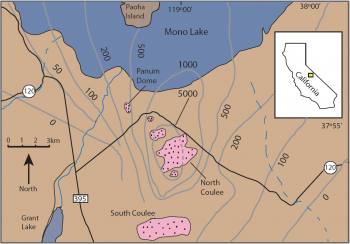Do Chlorine Isotopes Fractionate During Volcanic Degassing?
Tim Prather

The goal of this project is to determine empirically if chlorine isotopes fractionate during volcanic degassing by analyzing a 1340 A.D. eruption (Panum Crater) sequence of erupted obsidian clasts from Mono Craters, CA. By analyzing these obsidians for their H2O, CO2, and Cl concentrations, as well as their hydrogen and chlorine isotope values, we can determine if chlorine isotopes fractionate during the degassing event.
Chlorine isotopes are traditionally used as a conservative tracer system for tectonically mobilized fluids in subduction zone settings, which affect the melting points of rocks, alter the state of stress at depth, and metasomatize the mantle wedge. However, chlorine isotopes have not been empirically determined to behave as a conservative tracer and may display fractionation behavior in high temperature settings.

Samples were collected from Mono Craters and analyzed for their H2O, CO2, and Cl concentrations using Fourier Transform Infrared Spectroscopy and Electron Microprobe techniques, and for their hydrogen and chlorine isotope values using a dual inlet ThermoElectron MAT 253.
Our current results suggest that chlorine isotopes neither fractionate nor remain constant during volcanic degassing, implying that some other process is active during volcanic degassing. More results to come soon.
Supervisor: Jaime Barnes